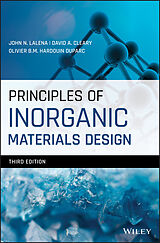Principles of Inorganic Materials Design
Format:
E-Book (EPUB)
EAN:
9781119486763
Genre:
Chemie
Autor:
John N. Lalena, David A. Cleary, Olivier B.M. Hardouin Duparc
Herausgeber:
Wiley
Anzahl Seiten:
720
Erscheinungsdatum:
10.04.2020
Learn the fundamentals of materials design with this all-inclusive approach to the basics in the field
Study of materials science is an important aspect of curricula at universities worldwide. This text is designed to serve students at a fundamental level, positioning materials design as an essential aspect of the study of electronics, medicine, and energy storage. Now in its 3rd edition, Principles of Inorganic Materials Design is an introduction to relevant topics including inorganic materials structure/property relations and material behaviors.
The new edition now includes chapters on computational materials science, intermetallic compounds, and covalent compounds. The text is meant to aid students in their studies by providing additional tools to study the key concepts and understand recent developments in materials research. In addition to the many topics covered, the textbook includes:
* Accessible learning tools to help students better understand key concepts
* Updated content including case studies and new information on computational materials science
* Practical end-of-chapter exercises to assist students with the learning of the material
* Short biographies introducing pioneers in the field of inorganic materials science
For undergraduates just learning the material or professionals looking to brush up on their knowledge of current materials design information, this text covers a wide range of concepts, research, and topics to help round out their education. The foreword to the first edition was written by the 2019 Chemistry Nobel laureate Prof. John B. Goodenough.
Autorentext
JOHN N. LALENA primarily focuses on the research of materials behavior and structure/property correlations across multiple length scales. He has over 25 years of experience in the private sector, including time spent at Honeywell Electronic Materials and Texas Instruments. He currently serves as a Physical Scientist in the Advanced Manufacturing Office at the U.S. Department of Energy. DAVID A. CLEARY is a Professor in the Department of Chemistry at Gonzaga University in Washington, USA. His research interests are in synthesis and characterization of ternary semiconductors for applications in chemical sensors and energy storage and in testing metal oxides for photoelectrolysis of water. OLIVIER B.M. HARDOUIN DUPARC is a researcher at the École Polytechnique Paris. His research primarily focuses on ab initio modeling of materials to unravel their atomic structure and mechanical properties.
Inhalt
Foreword to Second Edition xiii Foreword to First Edition xv Preface to Third Edition xix Preface to Second Edition xx Preface to First Edition xxi Acronyms xxiii 1 Crystallographic Considerations 1 1.1 Degrees of Crystallinity 1 1.1.1 Monocrystalline Solids 2 1.1.2 Quasicrystalline Solids 3 1.1.3 Polycrystalline Solids 4 1.1.4 Semicrystalline Solids 5 1.1.5 Amorphous Solids 8 1.2 Basic Crystallography 8 1.2.1 Crystal Geometry 8 1.2.1.1 Types of Crystallographic Symmetry 12 1.2.1.2 Space Group Symmetry 17 1.2.1.3 Lattice Planes and Directions 27 1.3 Single-Crystal Morphology and Its Relationship to Lattice Symmetry 32 1.4 Twinned Crystals, Grain Boundaries, and Bicrystallography 37 1.4.1 Twinned Crystals and Twinning 37 1.4.2 Crystallographic Orientation Relationships in Bicrystals 39 1.4.2.1 The Coincidence Site Lattice 39 1.4.2.2 Equivalent AxisAngle Pairs 44 1.5 Amorphous Solids and Glasses 46 1.5.1 Oxide Glasses 49 1.5.2 Metallic Glasses and MetalOrganic Framework Glasses 51 1.5.3 Aerogels 53 Practice Problems 53 References 55 2 Microstructural Considerations 57 2.1 Materials Length Scales 57 2.1.1 Experimental Resolution of Material Features 61 2.2 Grain Boundaries in Polycrystalline Materials 63 2.2.1 Grain Boundary Orientations 63 2.2.2 Dislocation Model of Low Angle Grain Boundaries 65 2.2.3 Grain Boundary Energy 66 2.2.4 Special Types of Low-Energy Boundaries 68 2.2.5 Grain Boundary Dynamics 69 2.2.6 Representing Orientation Distributions in Polycrystalline Aggregates 70 2.3 Materials Processing and Microstructure 72 2.3.1 Conventional Solidification 72 2.3.1.1 Grain Homogeneity 74 2.3.1.2 Grain Morphology 76 2.3.1.3 Zone Melting Techniques 78 2.3.2 Deformation Processing 79 2.3.3 Consolidation Processing 79 2.3.4 Thin-Film Formation 80 2.3.4.1 Epitaxy 81 2.3.4.2 Polycrystalline PVD Thin Films 81 2.3.4.3 Polycrystalline CVD Thin Films 83 2.4 Microstructure and Materials Properties 83 2.4.1 Mechanical Properties 83 2.4.2 Transport Properties 86 2.4.3 Magnetic and Dielectric Properties 90 2.4.4 Chemical Properties 92 2.5 Microstructure Control and Design 93 Practice Problems 96 References 96 3 Crystal Structures and Binding Forces 99 3.1 Structure Description Methods 99 3.1.1 Close Packing 99 3.1.2 Polyhedra 103 3.1.3 The (Primitive) Unit Cell 103 3.1.4 Space Groups and Wyckoff Positions 104 3.1.5 Strukturbericht Symbols 104 3.1.6 Pearson Symbols 105 3.2 Cohesive Forces in Solids 106 3.2.1 Ionic Bonding 106 3.2.2 Covalent Bonding 108 3.2.3 Dative Bonds 110 3.2.4 Metallic Bonding 111 3.2.5 Atoms and Bonds as Electron Charge Density 112 3.3 Chemical Potential Energy 113 3.3.1 Lattice Energy for Ionic Crystals 114 3.3.2 The BornHaber Cycle 119 3.3.3 Goldschmidt's Rules and Pauling's Rules 120 3.3.4 Total Energy 122 3.3.5 Electronic Origin of Coordination Polyhedra in Covalent Crystals 124 3.4 Common Structure Types 127 3.4.1 Iono-covalent Solids 128 3.4.1.1 AX Compounds 128 3.4.1.2 AX2 Compounds 130 3.4.1.3 AX6 Compounds 132 3.4.1.4 ABX2 Compounds 132 3.4.1.5 AB2&...

Leider konnten wir für diesen Artikel keine Preise ermitteln ...
billigbuch.ch sucht jetzt für Sie die besten Angebote ...
Die aktuellen Verkaufspreise von 2 Onlineshops werden in Realtime abgefragt.
Sie können das gewünschte Produkt anschliessend direkt beim Anbieter Ihrer Wahl bestellen.
Loading...
Die aktuellen Verkaufspreise von 2 Onlineshops werden in Realtime abgefragt.
Sie können das gewünschte Produkt anschliessend direkt beim Anbieter Ihrer Wahl bestellen.
| # | Onlineshop | Preis CHF | Versand CHF | Total CHF | ||
|---|---|---|---|---|---|---|
| 1 | Seller | 0.00 | 0.00 | 0.00 |
